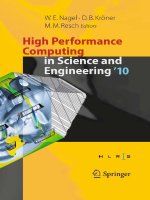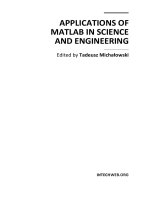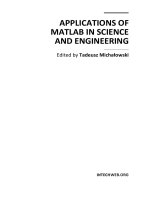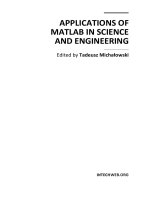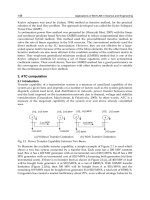high performance computing in science and engineering '10 transactions of the high performance computing center, stuttgart (hlrs) 2010
Bạn đang xem bản rút gọn của tài liệu. Xem và tải ngay bản đầy đủ của tài liệu tại đây (38.77 MB, 619 trang )
High Performance Computing in Science
and Engineering ’10
Wolfgang E. Nagel
r
Dietmar B. Kröner
r
Michael M. Resch
Editors
High Performance
Computing
in Science and
Engineering ’10
Transactions of the High Performance
Computing Center, Stuttgart (HLRS) 2010
Editors
Wolfgang E. Nagel
Zentrum für Informationsdienste
und Hochleistungsrechnen (ZIH)
Technische Universität Dresden
Zellescher Weg 12-14
01069 Dresden
Germany
Michael M. Resch
Höchstleistungsrechenzentrum
Stuttgart (HLRS)
Universität Stuttgart
Nobelstraße 19
70569 Stuttgart
Germany
Dietmar B. Kröner
Abteilung für Angewandte Mathematik
Universität Freiburg
Hermann-Herder-Str. 10
79104 Freiburg
Germany
Front cover figure: Temperature isosurface inside a lignite-fired utility boiler with a cross-sectional
area of 23 m
× 23 m and a height of 150 m. Institut für Feuerungs- und Kraftwerkstechnik, Univer-
sität Stuttgart
ISBN 978-3-642-15747-9 e-ISBN 978-3-642-15748-6
DOI 10.1007/978-3-642-15748-6
Springer Heidelberg Dordrecht London New York
Library of Congress Control Number: 2010938287
Mathematics Subject Classification (2010): 65Cxx, 65C99, 68U20
© Springer-Verlag Berlin Heidelberg 2011
This work is subject to copyright. All rights are reserved, whether the whole or part of the material is
concerned, specifically the rights of translation, reprinting, reuse of illustrations, recitation, broadcasting,
reproduction on microfilm or in any other way, and storage in data banks. Duplication of this publication
or parts thereof is permitted only under the provisions of the German Copyright Law of September 9,
1965, in its current version, and permission for use must always be obtained from Springer. Violations are
liable to prosecution under the German Copyright Law.
The use of general descriptive names, registered names, trademarks, etc. in this publication does not imply,
even in the absence of a specific statement, that such names are exempt from the relevant protective laws
and regulations and therefore free for general use.
Cover design: WMXDesign GmbH
Printed on acid-free paper
Springer is part of Springer Science+Business Media (www.springer.com)
The Gauss Centre for Supercomputing (GCS) – linking the three national su-
percomputing centres HLRS (Stuttgart), NIC/JSC (J¨ulich), and LRZ (Garch-
ing) – has established itself as the driving force for high-performance comput-
ing (HPC) in Germany, and, even beyond, in Europe. Based on the agreement
(Verwaltungsabkommen) between the Federal Ministry of Education and Re-
search (BMBF) and the state ministries for research of Baden-Wuerttemberg,
Bavaria, and North Rhine-Westphalia, the overall budget of 400 Million Euros
has been allocated – shared equally between federal and state authorities in
a five-year time period – to establish the next generation of HPC systems at
the GCS. Since the installation of the IBM Blue Gene/P at NIC/JSC in May
2009 – the first phase of the HPC Tier-0 resources – the GCS provides the
most powerful high-performance computing infrastructure in Europe today.
It is a pleasure to announce that the next major steps of this agreement
will be taken at the HLRS in 2011 and 2013. In 2009/2010, due to the support
of the state ministry for research of Baden-W¨urttemberg, the available CPU
resources were increased tenfold in an intermediate step, by replacing many
of the NEC SX-8 nodes with NEC SX-9/12M192 and installing a remarkably
large Intel Nehalem cluster. This has brought a peak performance of 80+
TFLOPs to the users of HLRS. Now, in October 2010 the next round of the
GCS infrastructure has been contracted, and the system at the HLRS will
be delivered by Cray Inc. in 2011 and 2013. The first delivery phase will
be a large Cray XT-6 with a peak speed of roughly 1 PFLOPS. In 2013,
in the second delivery phase the final system will be installed, and its peak
performance will be roughly 5 PFLOPS, more than twice as fast as the current
number-one TOP500-system, and more than 50 times faster than the current
systems at the HLRS. After the first upgrade of the HLRS system, the LRZ
will upgrade its systems accordingly. The plan is to have a Tier-0 HPC system
within the GCS operating at any time within the five year period.
As part of the GCS, HLRS also participates in the European project
PRACE (Partnership for Advances Computing in Europe), extending its reach
to all European member countries. Within the PRACE project, the GCS will
v
vi Preface
donate access to high performance computing resources valued at 100 million
Euros. These PRACE-activities align well with the activities of the HLRS
in the European HPC infrastructure project DEISA (Distributed European
Infrastructure for Supercomputing Applications) and in the European HPC
support project HPC-Europa2.
While the Gauss Centre for Supercomputing successfully addressed the
needs on the high end, it was clear from the beginning that an additional layer
of support was required to maintain the longevity of the Centre with a network
of competence centers across Germany. This gap is addressed by the Gauß–
Allianz, where regional and topical centers team up to create the necessary
infrastructure, knowledge and the required methods and tools. The mission
of the Allianz is to coordinate the HPC-related activities of its members. By
providing versatile computing architectures and by combining the expertise of
the participating centers, the ecosystem necessary for computational science
is created. Strengthening the research and increasing the visibility to compete
at the international level are further goals of the Gauß–Allianz.
At the moment, the entire HPC community in Germany is awaiting the
funding decisions of the second BMBF HPC-call of May 2010. This call is
directed towards proposals to enable and support petascale applications on
more than 100,000 processors. While the projects of the first funding round
started in early 2009, the follow-up call has been delayed by more than 18
months. Nevertheless, all experts and administration authorities continue to
see the strong need for such a program, given that the main issue seen in
nearly all applications is one of scalability. The strategic plan involves spend-
ing another 20 Million Euros each year over the next three years for projects to
develop scalable algorithms, methods, and tools to support massively parallel
systems. This may seem like a very large investment. Nevertheless, in relation
to the investment in hardware in Germany over this five years period, it is
still comparatively small. And furthermore, it will produce brains – brains we
will need in order to use the newly developed innovative methods and tools to
accomplish technological breakthroughs in scientific as well as industrial fields
of application. Even more, the target will not be the Petascale only but also
Exascale systems. As we all know, we do not only need competitive hardware
but also excellent software and methods to address – and solve – the most de-
manding problems in science and engineering. The success of this approach is
of significant importance for our community and will also greatly influence the
development of new technologies and industrial products; beyond that, this
will finally determine whether Germany will be an accepted partner alongside
the leading technology and research nations.
Since 1996, the HLRS has supported the scientific community as part of
its official mission. Just as in the past years, the major results of the last
12 months were presented at the 14th annual Results and Review Workshop
on High Performance Computing in Science and Engineering, which was held
on October 4–5, 2010 at the Stuttgart University. The workshop proceedings
contain the written versions of the research work presented. The papers were
Preface vii
selected from all projects running at the HLRS and the SSC Karlsruhe during
the one-year period beginning October 2009. Overall, 44 papers were chosen
from Physics, Solid State Physics, Reactive Flow, Computational Fluid Dy-
namics (CFD), Transport and Climate, and numerous other fields. The largest
number of contributions – as in many previous years – came from CFD with
16 papers. Even though such a small collection cannot entirely represent such
a vast area, the selected papers demonstrate the state-of-the-art in high per-
formance computing in Germany. The authors were encouraged to emphasize
computational techniques used in solving the problems examined. This often
forgotten aspect was the major focus of these proceedings. Nevertheless, the
importance of the newly computed scientific results for the specific disciplines
should not be disregarded.
We gratefully acknowledge the continuing support of the federal state of
Baden-W¨urttemberg in promoting and supporting high performance comput-
ing. Grateful acknowledgement is also due to the German Research Founda-
tion (Deutsche Forschungsgemeinschaft (DFG)), as many projects pursued on
the HLRS and SSC computing machines could not have been carried out with-
out its support. Also, we thank Springer Verlag for publishing this volume and,
thus, helping to position the local activities in an international framework. We
hope that this series of publications contributes to the global promotion of
high performance scientific computing.
Stuttgart, October 2010 Wolfgang E. Nagel
Dietmar Kr¨oner
Michael Resch
Physics
P. Nielaba 1
Spin-Liquid Phase in the Hubbard Model on the Honeycomb Lattice
Z.Y. Meng, T.C. Lang, S. Wessel, F.F. Assaad, and A. Muramatsu 5
Massive and Massless Four-Loop Integrals
J.H. K¨uhn, P. Marquard, M. Steinhauser, and M. Tentyukov 19
Ligand Protected Gold Alloy Clusters as Superatoms
M. Walter 29
The Chiral Critical Surface of QCD
Ph. de Forcrand and O. Philipsen 43
Mesoscopic Simulations of Polyelectrolyte Electrophoresis in
Nanochannels
J. Smiatek and F. Schmid 53
The SuperN-Project: An Update on Core-Collapse Supernova
Simulations
B. M¨uller, L. H¨udepohl, A. Marek, F. Hanke, and H Th. Janka 69
Higgs Boson Mass Bounds from a Chirally Invariant Lattice
Higgs-Yukawa Model
P. Gerhold, K. Jansen, and J. Kallarackal 85
Dust, Chemistry & Radiation Transport in MRI-Turbulent
Protoplanetary Discs
M. Flaig, W. Kley, R. Kissman, and P. Ruoff 103
Solid State Physics
W. Hanke 117
ix
x Contents
Organic-Metal Interface: Adsorption of Cysteine on Au(110) from First
Principles
B. H¨offling, F. Ortmann, K. Hannewald, and F. Bechstedt 119
Ab-initio Characterization of Electronic Properties of PbTe Quantum
Dots Embedded in a CdTe Matrix
R. Leitsmann and F. Bechstedt 135
Si(111)-In Nanowire Optical Response from Large-scale Ab Initio
Calculations
W.G. Schmidt, S. Wippermann, E. Rauls, U. Gerstmann, S. Sanna,
C. Thierfelder, M. Landmann, and L.S. dos Santos 149
Laser Ablation of Metals
J. Roth, C. Trichet, H R. Trebin, and S. Sonntag 159
Conductance and Noise Correlations of Correlated Nanostructures
A. Bransch¨adel and P. Schmitteckert 169
Cu Substitutionals and Defect Complexes in the Lead-Free
Ferroelectric KNN
S. K¨orbel and C. Els¨asser 181
Reacting Flows
D. Kr¨oner 189
Scalar Mixing in Droplet Arrays in Stagnant and Convective
Environments
A. Kronenburg, M.R.G. Zoby, S. Navarro-Martinez, and A.J. Marquis 191
Euler-Lagrange Simulation of a LOX/H2 Model Combustor with Single
Shear Coaxial Injector
M. Lempke, P. Gerlinger, M. Rachner, and M. Aigner 203
Simulation of Triflux Heat Exchangers in Utility Boilers
A. Matschke, M. M¨uller, U. Schnell, and G. Scheffknecht 217
Computational Fluid Dynamics
S. Wagner 229
Direct Numerical Simulation of Swept-Wing Laminar Flow Control
Using Pinpoint Suction
T.A. Friederich and M.J. Kloker 231
A Numerical Study of Turbulent Stably-Stratified Plane Couette Flow
M. Garc´ıa-Villalba, E. Azagra, and M. Uhlmann 251
Contents xi
DNS of Unsteady Heat Transfer Increase on a Curved Surface Due to
Wake-Induced Turbulence
D. von Terzi, L. Venema, H J. Bauer, and W. Rodi 263
Application of a Novel Turbulence Generator to Multiphase Flow
Computations
C. Huber, H. Gomaa, and B. Weigand 273
Numerical Investigation on the Deformation of Droplets in
High-Pressure Homogenizers
K. Kissling, S. Sch¨utz, and M. Piesche 287
Direct Numerical Simulation of Sediment Transport in Turbulent Open
Channel Flow
C. Chan-Braun, M. Garc´ıa-Villalba, and M. Uhlmann 295
Grid Sensitivity of LES Heat Transfer Results of a Turbulent Round
Impinging Jet
S.O. Neumann, N. Uddin, and B. Weigand 307
Large Eddy Simulations of a Jet in Crossflow
F.C.C. Galeazzo, P. Habisreuther, and N. Zarzalis 327
The Impact of Secondary Mean Vortices on Turbulent Separation in
3D Diffusers
D. von Terzi, H. Schneider, and H J. Bauer 339
Time-Dependent Three-Dimensional Simulation of the Turbulent
Flow and Heat Transfer in Czochralski Crystal Growth Including the
Three-Phase Boundary Movement
A. Raufeisen, M. Breuer, T. Botsch, and A. Delgado 353
Numerical Investigation of Shock Wave Boundary-Layer Interaction
Using a Zonal RANS-LES Ansatz
B. Roidl, M. Meinke, and W. Schr¨oder 369
Large Eddy Simulation of the Cyclic Variations in an Internal
Combustion Engine
F. Magagnato, A. Walcker, and M. Gabi 385
CFD-CSD-Coupled Simulations of Helicopter Rotors Using an
Unstructured Flow Solver
F. Bensing, M. Keßler, and E. Kr¨amer 393
Wake Signature of Finite-Span Flapping Rigid Wings
J.E. Guerrero 407
xii Contents
Computational Design Study of a 3D Hypersonic Intake for Scramjet
Demonstrator Testing
B. Reinartz and M. Behr 429
Characterization of Mixing in Food Extrusion and Emulsification
Processes by Using CFD
M.A. Emin, K. K¨ohler, M. Schlender, and H.P. Schuchmann 443
Transport and Climate
C. Kottmeier 463
Modelling Regional Climate Change in Germany
P. Berg, H J. Panitz, G. Sch¨adler, H. Feldmann, and C. Kottmeier 467
Modelling the Extratropical Transition of Tropical Cyclones and Its
Downstream Impact
C.M. Grams and S.C. Jones 479
Global Long-Term MIPAS Data Processing: Some Aspects of the
Dynamics of the Atmosphere from Lower Stratosphere to Lower
Thermosphere
M. Kiefer, B. Funke, U. Grabowski, and A. Linden 501
Miscellaneous Topics
W. Schr¨oder 515
Computer Simulation for Building Implosion Using LS-DYNA
G. Michaloudis, S. Mattern, and K. Schweizerhof 519
Quaero Speech-to-Text and Text Translation Evaluation Systems
S. St¨uker, K. Kilgour, and J. Niehues 529
Molecular Modeling of Hydrogen Bonding Fluids: Transport Properties
and Vapor-Liquid Coexistence
J. Vrabec, G. Guevara-Carrion, T. Merker, and H. Hasse 543
Software Framework UG: Parallel Simulation of a Three-Dimensional
Benchmark Problem for Thermohaline-Driven Flow
M. Lampe, A. Grillo, and G. Wittum 553
Tailored Usage of the NEC SX-8 and SX-9 Systems in Satellite
Geodesy
M. Roth, O. Baur, and W. Keller 561
A Geodynamic Model of the Evolution of the Earth’s Chemical Mantle
Reservoirs
U. Walzer and R. Hendel 573
Contents xiii
Three-Dimensional Simulation of Rarefied Plasma Flows Using a High
Order Particle in Cell Method
J. Neudorfer, T. Stindl, A. Stock, R. Schneider, D. Petkow, S. Roller,
C D. Munz, and M. Auweter-Kurtz 593
Prof. Dr. Peter Nielaba
Fachbereich Physik, Universit¨at Konstanz, 78457 Konstanz, Germany
The contributions to the HLRS proceedings present the results of large scale
simulations for elementary particle models, nano-systems, soft matter systems
and astrophysics phenomena. Several important results have been achieved
by the computer time granted at the HLRS, in several cases resulting in
publications in prestigious journals like Nature and Physical Review Letters.
Z.Y. Meng, T.C. Lang, S. Wessel, F.F. Assaad, and A. Muramatsu
(Stuttgart University and W¨urzburg University) have analyzed the Hubbard
model of spin-1/2 fermions on the honeycomb lattice at half-filling using large-
scale quantum Monte Carlo simulations. The authors find that the weak cou-
pling semimetal and the antiferromagnetic Mott insulator at strong interac-
tion are separated by an extended gapped phase in an intermediate coupling
regime. Exploring excitation gaps, various correlation functions as well as
probing for flux quantization, they conclude that a quantum spin liquid, lack-
ing any conventional order, emerges with local charge and spin correlations,
best described by a resonating valence bonds state.
J.H. K¨uhn, P. Marquard, M. Steinhauser and M. Tentyukov from the
KIT Karlsruhe have investigated massive and massless four-loop integrals,
the computations were mainly performed on the Landesh¨ochstleistungsrechner
XC4000. The problems treated within their project aim for the evaluation of
so-called Feynman diagrams which in turn lead to quantum corrections within
a given quantum field theory like Quantum Electrodynamics or Quantum
Chromodynamics but also supersymmetric theories. The typical CPU time
reaches from several hours to several months depending on the concrete prob-
lem under consideration. In order to be able to manipulate huge expressions
a special tool is necessary. The workhorse of the authors for such calculations
is the computer algebra program FORM and its parallel versions ParFORM
and TFORM. The parallelization concept for FORM is quite simple: The
original expression is divided into several pieces which are then distributed to
the individual processors or cores (workers). Once the workers have finished
their job the resulting expressions have to be collected by one processor which
combines the results. A computer architecture running ParFORM or TFORM
1
2 P. Nielaba
requires a fast connection to the (in general) local hard disks of the order of
one terabyte per core.
Michael Walter from the University of Freiburg studied the properties
of clusters by density functional theory (DFT). The DFT calculations used
in his studies were performed at the RZ Karlsruhe with the real-space grid
code GPAW using a generalized gradient approximation, and the Kohn-Sham
states were represented via the projector-augmented wave method. The author
shows in his contribution for two experimentally characterized clusters that
the super-atom-picture found for pure Au clusters applies equally well to
protected Au alloy clusters. The stability of these clusters is a consequence of
the 8-electron shell closing, where the elements Ag and Au donate one and the
elements Pd and Pt donate no electron to the set of delocalized electrons. The
author proposes the stability of clusters similar to the stable thiol protected
Au
25
(SR
3
)
18
via the replacement of one of the Au atoms by X=Pd, Ag and
Cd, and he shows, that the stability of the well known carbonyl protected
nickel-silver/gold clusters is governed by delocalized electronic shell closings.
The clusters not only separate sterically, but also electronically into nickel-
carbonyl and silver/gold subsystems.
Ph. de Forcrand from the ETH Z¨urich and O. Philipsen from the Uni-
versityofM¨unster have calculated the critical surface bounding the region
featuring chiral phase transitions in the quark mass and chemical potential
parameter space of quantum chromo dynamics (QCD) with three flavours
of quarks. Their calculations are valid for small to moderate quark chemical
potentials, μ ≤ T. For their Monte Carlo simulations the authors used the
standard Wilson gauge and Kogut-Susskind fermion actions. Configurations
are generated using the Rational Hybrid Monte Carlo (RHMC) algorithm. The
simulations have been performed on the NEC SX-8 at the HLRS in Stuttgart
and the EEGE Grid at CERN. An estimate of the Binder cumulant for one
set of mass values consisted of at least 200k trajectories, and the estimate of
a critical point required at least 500k trajectories.
Jens Smiatek from the University of M¨unster and Friederike Schmid from
the University of Mainz in their project focused on the DPD simulation of cou-
pled electrohydrodynamic phenomena on the microscale like polyelectrolyte
dynamics in microchannels in external electric fields. The effects of electroos-
motic flow and slippage combined with polyelectrolyte electrophoresis have
been investigated in detail by taking full account of hydrodynamic and elec-
trostatic interactions. All simulations in this work have been carried out by
extensions of the software package ESPResSo (An Extensible Simulation Pack-
age for Research on Soft matter). One of the programs advantages is its high
performance MPI-parallelisation implemented for simulations on supercom-
puters. The simulations have been run on the NEC SX-8 Cluster at the HLRS.
The authors show that the product of the inverse screening length and the
slip length massively influences the electroosmotic flow and therefore the total
mobility of the polyelectrolyte. An important result of their study is that the
characteristics of the boundaries have to be taken into account for a proper de-
Physics 3
scription of the polyelectrolyte migration dynamics. Even a negative mobility
for certain parameter sets can be achieved, which has been observed in recent
experiments. The characteristics of the channel walls could be used to signif-
icantly enhance flow profiles, which offers the possibility to reduce the time
which is needed for polymer migration or separation techniques. This could be
an important aspect for future applications in microchannels or micropumps
to accelerate the measuring time in experiments.
B. M¨uller, L. H¨udepohl, A. Marek, F. Hanke, and H Th. Janka from the
MPI for Astrophysics in Garching have investigated two-dimensional (core
collapse) supernova by simulations and give an overview on the relevant equa-
tions and the algorithm for its solution that are employed in their code, and
report on their efforts to improve the physics in their supernova code VER-
TEX as well as its the computational efficiency. Recent results of simulations
performed on the NEC SX-8 at the HLRS include the first multi-dimensional
general-relativistic neutrino transport simulations conducted with a new ex-
tension of the VERTEX code as well as simulations of neutron star cooling
over several seconds for different nuclear equations of state.
Philipp Gerhold, Karl Jansen, and Jim Kallarackal from the Humboldt
University and DESY Zeuthen considered a chirally invariant lattice Higgs-
Yukawa model based on the Neuberger overlap operator. The model is eval-
uated using PHMC-simulations and the authors present final results on the
upper and lower Higgs boson mass bound. The question of a fourth genera-
tion of heavy quarks has recently gained attention and the authors illustrate
preliminary results of the Higgs boson mass bounds within this framework.
The authors as well discuss their progress on properties of the Higgs boson
with respect to its unstable nature, such as the decay width and the resonance
mass of the Higgs boson.
Markus Flaig and Patrick Ruoff from the University of T¨ubingen stud-
ied dust, chemistry and radiation transport in magneto-rotational instabil-
ity (MRI)-turbulent protoplanetary discs. The authors aim at setting up 3D
protoplanetary disc models that include all the physically relevant factors,
namely magnetic fields, radiation transport, chemistry and dust, in a self-
consistent manner. They present results from radiative models (neglecting
dust and chemistry), where for the first time radiation transport has been in-
cluded into a 3D turbulent protoplanetary disc model. Their models achieve
a quasi-steady state of saturated turbulence, where the turbulent heating is
balanced by cooling due to radiation transport. For sufficiently high resolu-
tion, the turbulent saturation level shows a trend to converge towards a value
of α ∼ 2.
on the Honeycomb Lattice
Z.Y. Meng
1
, T.C. Lang
2
, S. Wessel
1
, F.F. Assaad
2
, and A. Muramatsu
1
1
Institut f¨ur Theoretische Physik III, Universit¨at Stuttgart, Pfaffenwaldring 57,
D-70550 Stuttgart, Germany
2
Institut f¨ur Theoretische Physik und Astrophysik, Universit¨at W¨urzburg, Am
Hubland, 97074 W¨urzburg, Germany
Summary. The Hubbard model encapsulates the physics of strongly correlated
quantum systems in its most basic form. It has been studied intensively in the
context of the high-temperature superconductivity. A number of novel phases were
recently proposed for Hubbard-like models on the honeycomb lattice, the structure
of graphene. We analyzed the Hubbard model of spin-
1
2
fermions on the honeycomb
lattice at half-filling using large-scale quantum Monte Carlo simulations. We find
that the weak coupling semimetal and the antiferromagnetic Mott insulator at strong
interaction are separated by an extended gapped phase in an intermediate coupling
regime. Exploring excitation gaps, various correlation functions as well as probing for
flux quantization, we conclude that a quantum spin liquid, lacking any conventional
order, emerges with local charge and spin correlations, best described by a resonating
valence bonds state.
1Overview
The work that we present in the remainder of this report was published re-
cently in Nature [1]. Apart from the work detailed below, we considered in the
last grant period the following topics: We analyzed spin textures induced by
magnetic impurities in two-dimensional quantum antiferromagnets by using
quantum Monte Carlo simulations [2]. We showed that for weak coupling of
the impurity spin to the host magnet, the antiferromagnetic order is enhanced
throughout the host system, whereas a strong impurity coupling leads to an
overall reduction of the antiferromagnetism apart from a local enhancement of
the order parameter in the closest vicinity of the impurity spin. Furthermore,
we studied the finite-temperature ordering of defect-induced magnetic mo-
ments in graphene [3], based on an effective spin-model that accounts for the
long-ranged RKKY interactions mediated among the moments by the conduc-
tion electrons. We verified the mean-field character of the finite-temperature
ordering transition, and analyzed the dependence of the N´eel temperature on
the defect concentration. This exhibited a crossover in the system’s response
W.E. Nagel et al. (eds.), High Performance Computing in Science
and Engineering ’10,DOI10.1007/978-3-642-15748-6
1,
© Springer-Verlag Berlin Heidelberg 2011
5
6 Z.Y. Meng et al.
between a low-doping shortest-distance behavior and a high-doping mean-
field regime. Furthermore, we analyzed the magnetocaloric effect in spin-S
chains by using a combination of quantum Monte Carlo simulations and ex-
act numerical diagonalization [4], extending previous investigations towards
the regime S ≥ 1. Moreover, within the context of ultra-cold atoms on optical
lattices, a major current effort aims at realizing within the Mott-insulating
regime an antiferromagnetically ordered state. With respect to optimizing the
cooling efficiency, it is important to obtain accurate estimates of the critical
entropy required for the antiferromagnetic N´eel state to resist thermal fluctu-
ations. We obtained accurate quantum Monte Carlo estimates for this critical
entropy for quantum magnets on simple-cubic lattices, and compared our nu-
merical findings to recent estimates on this quantity [5]. We also devised a
method for reaching low entropy states for fermions on optical lattices. That
method, which we termed quantum distillation, consists on simply letting the
fermionic system expand while the strength of the contact interaction U is
maintained at a value much larger than the bandwidth of the fermions. Our
simulations showed that essentially a Fock-state with 2 fermions per site is
left behind the expanding cloud, and hence a very low entropy state [6].
2 Introduction
The current interest in spin liquids (SL) goes back to seminal work by P. W.
Anderson on resonating valence bonds states (RVB), their relevance to the
antiferromagnetic (AF) quantum Heisenberg model on low-dimensional lat-
tices [7, 8], and implications on a possible mechanism for superconductivity
in the cuprates [9, 10]. There is however compelling evidence, that on the
square [11], triangular [12] and honeycomb lattice [13], the nearest-neighbor
Heisenberg model does not realize such SL states, but instead long-range mag-
netic order survives quantum fluctuations. The situation is less clear for the
Hubbard model, to which the Heisenberg model provides the low-energy effec-
tive theory at half-filling and strong coupling. On the square lattice, a nested
Fermi-surface induces an AF state at half-filling for any finite value of the
onsite repulsion [14, 15]. For the triangular lattice, there are indications for
a SL phase within an intermediate coupling regime [16, 17]. Concerning the
bipartite honeycomb lattice, previous studies [18–22] suggested that in the
absence of nesting effects, a single quantum phase transition separates the
paramagnetic weak-coupling semimetal (SM) phase from a strong-coupling
AF Mott insulator (MI), without the details of this transition having been
explored.
More recently, field-theoretical studies and lattice gauge theory simula-
tions addressed the nature of an interaction-driven quantum phase transition
between a SM and a MI on the honeycomb lattice [23–28]. Such studies focus
on the charge sector, and proceed within a relativistic low-energy theory de-
rived from the linear dispersion observed, e.g., in graphene around the Dirac
Spin-Liquid Phase in the Hubbard Model on the Honeycomb Lattice 7
points at the Fermi energy. On the other hand, various proposals have been
put forward that additional phases, e.g. (algebraic) SL [25], charge density
wave order [29, 30], quantum (spin) Hall states [30–32], or superconductiv-
ity [29, 33–36] emerge in Hubbard-like models on the honeycomb lattice at,
or near half-filling. Given these developments, it is thus important to explore
the ground state properties in the intermediate coupling regime of the orig-
inal lattice model, in particular, given the absence of a sign-problem when
applying unbiased large-scale quantum Monte Carlo (QMC) simulations in
the half-filled case.
3 Model and Method
Before presenting our results from such an unbiased approach to the physics
of interacting electrons on the honeycomb lattice, in this section, we introduce
the model and the numerical method. The Hamiltonian of the spin-
1
2
Hubbard
model on the honeycomb lattice reads
H = −t
i,j,α
(c
†
iα
c
jα
+ c
†
jα
c
iα
)+U
i
n
i↑
n
i↓
, (1)
where c
iα
(c
†
iα
) denotes the annihilation (creation) operator for fermions of
spin α =↑, ↓ on lattice site i; n
iα
= c
†
iα
c
iα
, t sets the nearest-neighbor hopping
amplitude, and U ≥ 0 the strength of the onsite repulsion.
Our notations on the bipartite honeycomb lattice with the two sublattices
A and B and a two-site unit cell in real space, as well as the momentum
space are shown in Fig. 1a and b. We also introduce c
†
xAα
and c
†
xBα
(c
xAα
and
c
xBα
) to denote creation (annihilation) operators for fermions of spin α =↑
or ↓, on the lattice site that belongs to the sublattice A and B respectively,
within the unit cell at position x. Likewise, n
xaα
= c
†
xaα
c
xaα
and n
xa
=
α
n
xaα
denote the local density operators, and S
xa
=
1
2
c
†
xaα
σ
α,β
c
xaβ
the
local spin operators, where σ =(σ
x
,σ
y
,σ
z
) is the vector of Pauli matrices
with a ∈{A, B}. The corresponding operators in k-space are obtained from
the Fourier transformation
c
kaα
=
1
L
2
x
e
−ik(x+x
a
)
c
xaα
, (2)
where x
A
=(0,0) and x
B
=(0,a), with a the distance between neighboring
lattice sites. Similarly, Fourier components n
kaα
, n
ka
and S
ka
of the density
and spin operators are defined.
At U = 0, the tight-binding Hamiltonian has a linear dispersion near
the Dirac points (K, K
), where the conduction and valence bands touch at
half-filling (c.f. Fig. 1c), and correspondingly, the density of state vanishes
at the Fermi energy (c.f. Fig. 1d), rendering the non-interacting system a
8 Z.Y. Meng et al.
Fig. 1. Honeycomb lattice in real (a) and momentum space (b). In a, the unit
cell is indicated, and the lattice vectors a
1
=
√
3a(1, 0) and a
2
=
√
3a/2(1,
√
3),
with a equal to the distance between neighboring lattice sites. Open (full) circles
indicate the sublattice A (B). In b, the Dirac points K and K
,theM and the Γ
point are indicated, and the reciprocal lattice vectors b
1
=2π/(3a)(
√
3, −1) and
b
2
=4π/(3a)(0, 1). The free dispersion relation (k)isshowninc,wheretheπ and
π
∗
bands touch each other at K and K
, this leads to a linearly vanishing density
of states (DOS) at the Fermi level at half-filling (d)
semimetalic ground state. At half-filling, the finite-U region can be studied
using projective (temperature T = 0) auxiliary field QMC simulations in the
canonical ensemble. To obtain the ground state expectation values of physical
observables A, one calculates
A = lim
Θ→∞
Ψ
T
|e
−ΘH/2
Ae
−ΘH/2
|Ψ
T
Ψ
T
|e
−ΘH
|Ψ
T
, (3)
where the trial wavefunction |Ψ
T
must be non-orthogonal to the ground state.
For details on the algorithm, see Refs. [37]. We study lattices of N =2L
2
sites
with periodic boundary conditions, and linear sizes up to L = 18. We found
the projection parameter Θ =40/t and an imaginary-time step Δτ =0.05/t
in the second-order Trotter decomposition to lead to converged quantities.
Spin-Liquid Phase in the Hubbard Model on the Honeycomb Lattice 9
4Results
In this section, we present a detailed analysis of our QMC data, in which
we focus in particular on the region near the Mott transition. The anal-
ysis leads to the conclusion, that a gapped SL phase exists in the Hub-
bard model on the honeycomb lattice, separating the paramagnetic SM from
the AF MI.
To monitor the electronic properties of the system upon increasing U,we
extracted the single-particle excitation gap Δ
sp
(k) from the imaginary-time
displaced Green’s function,
G(k,τ)=
1
2
a
c
†
ka↑
(τ)c
ka↑
(0) =
1
2
a
c
†
ka↓
(τ)c
ka↓
(0),
with c
†
kaα
(τ)=e
τH
c
†
kaα
e
−τH
. At large imaginary time τ,
G(k,τ) ∝ exp(−τΔ
sp
(k)),
and Δ
sp
(k) corresponds to the lowest-lying particle (or hole) excitation energy.
At U = 0, the single-particle gap vanishes at the Dirac points K and K
,and
we thus consider Δ
sp
(K) in the following. To obtain a robust estimate of
Δ
sp
(K) for each value of U and each linear system size L, we diagonalized
the covariance matrix to minimize the correlation among QMC data before
fitting the lowest exponential decay of the QMC data (main panel of Fig. 2).
Then we extrapolated Δ
sp
(K) for various fitting ranges in terms of varying
the starting point τ
start
, as seen in the inset of Fig. 2. Finally, we took the
converged values of Δ
sp
(K) and perform the finite size scaling to obtain the
thermodynamic limit estimation of the gaps for different U values. Eventually,
we also performed the same procedure to obtain the spin excitation gaps
Δ
s
(Γ )andΔ
u
(Γ ). Figure 3 shows the finite size scaling of the single-particle
gap for different U values. We also performed the bootstrapping analysis as
shown in the inset. Clearly, a single-particle gap opens beyond U/t ≈ 3.5,
signaling the break-down of the weak-coupling SM.
From previous investigations of the model, one expects long-range anti-
ferromagnetic correlations beyond this point. The AF order resides within
the unit cell of the honeycomb lattice, and we therefore measured the
spin structure factor related to the staggered spin correlations at the Γ
point
S
AF
= [
x
(S
xA
− S
xB
)]
2
/N . (4)
Figure 4 shows the QMC results together with a finite size extrapolation. AF
order appears beyond U/t ≈ 4.3, a value that is consistent with previous esti-
mates for the onset of long-ranged AF order [18, 21]. This leaves an extended
window 3.5 <U/t<4.3, within which the system is neither a SM, nor an AF
MI.
10 Z.Y. Meng et al.
Fig. 2. Green’s function at the Dirac point G(K, τ) for different system sizes at
U/t =3.8. The inset shows the determination of Δ
sp
(K) as a function of the starting
point of the fitting range τ
start
with the covariance matrix of the Green’s function
taken into account
Further details on the nature of this intermediate region are obtained by
examining the spin excitation gap, obtained from the long-time behavior of
the imaginary-time displaced spin-spin correlation function. In the staggered
sector at k = 0, the correlation function is
S
s
(k,τ)=(S
kA
(τ) −S
kB
(τ)) ·(S
kA
(0) − S
kB
(0)). (5)
When τ is large enough, the spin gap Δ
s
(Γ ) is obtained from
S
s
(Γ, τ) ∝ exp(−τΔ
s
(Γ )).
The gap vanishes inside the AF phase due to the emergence of a Goldstone
mode, as well as in the gapless SM phase. After performing the same analyzing
procedures of QMC raw data as that of the single-particle gap, Fig. 5 shows
finite size estimates of Δ
s
(Γ ) for different values of U/t, along with an extrap-
olation to the thermodynamic limit. A finite value of Δ
s
(Γ ) persists within
an intermediate parameter regime 3.5 <U/t<4.3, while it vanishes both
within the SM and the AF phase. This dome in the spin gap is also seen in
the inset of Fig. 5, which shows both the finite-size data and the extrapolated
values of Δ
s
(Γ ) as functions of U/t. We also calculated the uniform spin gap
Δ
u
(Γ ) by extrapolating the spin gap observed at the smallest finite k-vector

